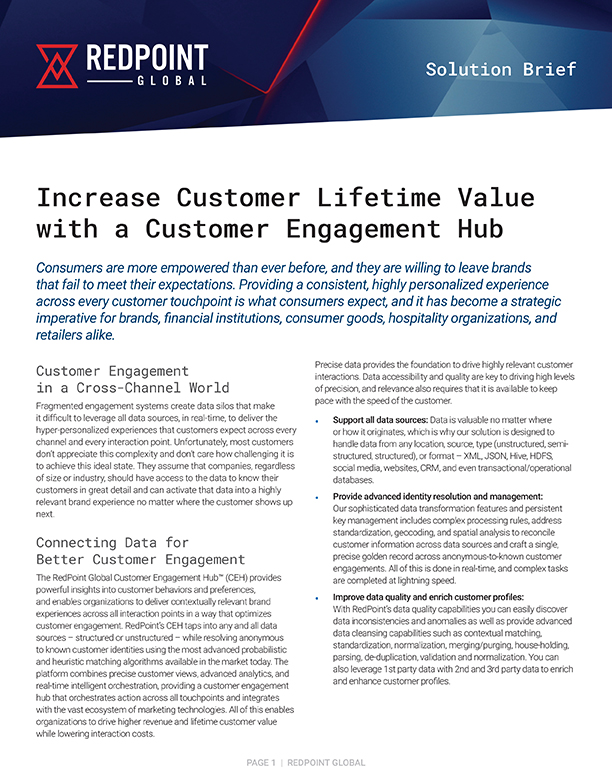 It’s abundantly clear that customers’ expectations are greater than ever and climbing higher with every disruptive startup and technology. What’s not so clear to many marketers is how they can meet those expectations without busting their budget—or losing their sanity.
It’s abundantly clear that customers’ expectations are greater than ever and climbing higher with every disruptive startup and technology. What’s not so clear to many marketers is how they can meet those expectations without busting their budget—or losing their sanity.
Although it’s unlikely that you can meet all your customers’ high expectations all the time, you’re far more likely to meet them by getting the most from the customer data available to you. With the right processes and technologies, you can access far more data, much more quickly, than you may think is possible.
No need to rip and replace what works or look far beyond the data already in your sphere. By using a customer experience hub (CEH) to create a holistic view of the customer and serve as a single-point-of-control over customer data and interactions you can overcome many of the challenges you currently have in delivering the experiences your customers expect.
Providing and maintaining a superior customer experience—that is, one that’s relevant and personalized—not only delights the customer, it also pays dividends for your organization. Customers will feel recognized and valued, and as a result, will spend more, more often recommend and advocate, and, over time, cost less to retain. A CEH is the rock-solid foundation of your profitable, future-proof CX strategy.
Stark Realities
According to the “Wantedness” report by marketing agency Wunderman, 63 percent of U.S. customers consider great brands as the ones that exceed their expectations across the entire customer journey. Loyalty apps and programs; comparison and review web sites; social media for sharing and showing interactions and products — these advances have put the consumer squarely in charge of the buying experience. As a result, many customers expect purchase experiences that are tailored uniquely to them. About three quarters of consumers say receiving personalized discount offers based on their purchase history is important and a study from Marketing Insider Group states that 78 percent of consumers say personally relevant content increases their purchase intent.
As these empowered consumers’ demands grow and their expectations increase, marketers need the ability to respond — in real time. Today, more than 60 percent of consumers are always-on and readily addressable. Using a CEH to support a real-time synchronous interaction model is the only way to speak to customers with the relevancy (content, timing, etc.) they want in the channels they prefer.
By providing a single-point-of-control over data and customer journeys, a CEH helps marketers overcome silos of data, business rules, and processes and enables them to deliver seamless, hyper-personalized interactions at the speed of the customer. That single-point-of-control allows marketers to implement a real-time synchronous interaction model to orchestrate customer interactions across an entire lifecycle.
A real-time interaction model allows marketers to respond effectively despite the proliferation of channels, touchpoints, and data. Channels and touchpoints include far more than the obvious mobile, social, on-premise, email and website. Beacons, IoT, and sensors are examples of touchpoints that marketers can use to improve the customer experience. And it’s essential that they do: Research from consultancy McKinsey & Company found that more than 50 percent of customer journeys are now multievent and multichannel.
Those touchpoints aren’t just vital customer interaction points, they also exemplify the ever-expansive sources of data available to marketers. These include anonymous-to-known customer, structured and unstructured, batch and streaming, and first-, second-, and third-party data — sources of invaluable information that includes customer behavior, transactions, preferences and ultimately intent.
More is more
Using a CEH, it’s possible to access all the data in real time, so marketers can know all that is knowable about their customers with little latency — and without breaking the bank or ripping and replacing their tech stack. The more information marketers have on customers, the more valuable it is. For example, having behavioral data may reveal the need to respond within a given timeframe and in a specific channel. Additionally, when a company’s systems are connected it allows marketers to use automation to make a next-best offer and enable customers to act on it in whatever channel they’re in.
One challenge marketers face in implementing this vital real-time synchronous interaction model is the fragmentation brought about by the accelerated pace of technology innovation. The more specialized technologies that are introduced to the market, the more potential there is for marketers to add silos to their already disjointed marketing technology stacks.
A CEH provides marketers with an open-garden approach that links disparate data sources to create a holistic, always-updating view of the customer. This is a must to overcome the obstacles of siloed data and technologies and support and enable the single-point-of-control that allows marketers to reach their customers in real-time in the customers’ chosen touchpoints. Plus, it helps to extend the value of existing marketing technology investments and future-proof the enterprise to take advantage of any technology innovations to come.
Holistic Customer View
Three quarters of marketing executives polled believe that it’s possible to get that holistic customer view, according to research from Redpoint Global conducted with the CMO Council. The challenge, respondents say, include having a single customer record that is embraced by all functions (65 percent), the right technologies (53 percent), and cross-functional data (52 percent).
A single-point-of-control over data and real-time interactions is a foundational element that marketers can use to gain that holistic view of the customer and build and maintain a superior customer experience. With a CEH you can delight your customers with personalized experiences that show you know and value them. In return, they’ll buy more and buy more often, recommend and advocate for your brand, and costs less to serve—increasing their lifetime value.
Research firm Gartner predicts that, by 2020, more than 40 percent of all data analytics projects will relate to an aspect of CX. Don’t wait. Use your customer data to create a competitive advantage today.
RELATED ARTICLES
One Point of Control, Many Benefits
Why Data Scientists Should Care about Customer Experience
How to Personalize Retail Interactions Without Being Creepy
Be in-the-know with all the latest customer engagement, data management and Redpoint Global news by following us on LinkedIn, Twitter, and Facebook.

